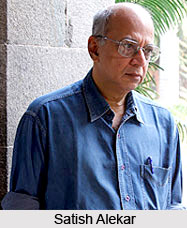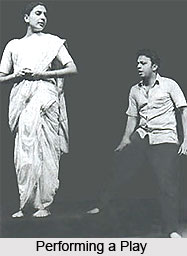 Satish Alekar is a Marathi dramatist, actor, and director. He was born in Delhi, in a politically and socially liberal family in the year 1949. Satish Alekar, this famous theatre personality grew up in a conservative old quarter of Pune, the stronghold of Marathi culture. Professionally he was a biochemist; he gained his first stage experience as a replacement actor in a college production. The director, Bhalba Kelkar, who ran the Progressive Dramatic Association set up to offer meaningful theatre in Pune, was sufficiently impressed by Alekar`s performance to invite him to join. Alekar became part of a young theatre-study circle that Jabbar Patel had started within the organization. This group split with the parent body in 1973 over Vijay Tendulkar`s Ghashiram Kotwal. The senior members reacted against its premiere in 1972 while Patel`s band decided to continue it and set up their own unit, the Theatre Academy, who have produced Alekar`s major plays ever since.
Satish Alekar is a Marathi dramatist, actor, and director. He was born in Delhi, in a politically and socially liberal family in the year 1949. Satish Alekar, this famous theatre personality grew up in a conservative old quarter of Pune, the stronghold of Marathi culture. Professionally he was a biochemist; he gained his first stage experience as a replacement actor in a college production. The director, Bhalba Kelkar, who ran the Progressive Dramatic Association set up to offer meaningful theatre in Pune, was sufficiently impressed by Alekar`s performance to invite him to join. Alekar became part of a young theatre-study circle that Jabbar Patel had started within the organization. This group split with the parent body in 1973 over Vijay Tendulkar`s Ghashiram Kotwal. The senior members reacted against its premiere in 1972 while Patel`s band decided to continue it and set up their own unit, the Theatre Academy, who have produced Alekar`s major plays ever since.
Alekar had cut his directorial and playwriting teeth on a one-act college show, Jhultapul or `Swinging Bridge` in 1969. After that he assisted Patel to direct Ghashiram Kotwal. His first full-length script was Miki ani memsaheb i.e. `Miki and the Memsahib` in 1974. With the exception of Mahapur i.e. `Great Flood` in 1975, he went on to direct all his plays. Alekar`s best known work, Mahanirvan or `Great Nirvana` in 1973, translated as The Dread Departure, one act in its first draft, was later expanded by him at Patel`s insistence and ran intermittently till 1987. His most complex play, Begum Barve in 1979, considered a classic of contemporary Marathi theatre, deals with the eponymous female impersonator`s memories and fantasies.
 A minor singer-actor cast out on the streets after his musical company closed down, he now sells incense sticks and is brutally exploited by his employer. On a magical day his fantasies get enmeshed with those of a pair of clerks, his regular customers, and are almost fulfilled. Satish Alekar`s other plays comprise Shanivar-ravivar i.e. `Saturday and Sunday, 1982 and Dusra samna i.e. `Second Confrontation` in 1987. Both of them were conventionally structured and produced for the mainstream stage, and Atireki i.e. `Extremist` in 1990), which marked a return to his earlier mode of irony, wit, and tangential take-offs from absurd premises. He has also written a few screenplays, and was appointed director of the Lalit Kala Kendra, Pune University, in 1996.
A minor singer-actor cast out on the streets after his musical company closed down, he now sells incense sticks and is brutally exploited by his employer. On a magical day his fantasies get enmeshed with those of a pair of clerks, his regular customers, and are almost fulfilled. Satish Alekar`s other plays comprise Shanivar-ravivar i.e. `Saturday and Sunday, 1982 and Dusra samna i.e. `Second Confrontation` in 1987. Both of them were conventionally structured and produced for the mainstream stage, and Atireki i.e. `Extremist` in 1990), which marked a return to his earlier mode of irony, wit, and tangential take-offs from absurd premises. He has also written a few screenplays, and was appointed director of the Lalit Kala Kendra, Pune University, in 1996.
Satish Alekar conceived and successfully implemented programmes like Playwrights Development Scheme and Regional Theater Group Development. These were supported by the Ford Foundation for Theatre Academy, Pune since 1985 to 1994. Satish Alekar is the recipient of several National and State awards since 1973 for his contribution to the field of Theatre and Literature. He received Nandikar Sanman at Calcutta in 1992 and fellowships from the Asian Cultural Council, New York in 1983 to study Theatre in U. S. and from the Ford Foundation to study Theatre of South Asia in 1988. He received National Award for the playwriting in 1994-95 from Sangeet Natak Akademi, Delhi. He scripted the national award winning Marathi feature film Jait Re Jait in 1977 and directed a Hindi T.V. Serial in 13 parts Dekho Magar Pyarse for Doordarshan in 1985. He also scripted the dialogues for Marathi feature film Katha Don Ganpatravanchi produced by N.F.D.C. in 1995-96.
His published plays are available with Neelkanth Prakashan, Pune in Marathi and Seagull Book, Calcutta in English. Many of his plays have been translated, produced and published in several Indian regional languages. These are Hindi, Tamil, Dogri, Kannada, Gujarathi, Rajasthani, Punjabi, and Konkni. His plays also included in the National Anthologies published by the National School of Drama and Sahitya Akademi, Delhi published in 2000-01. Satish Alekar has also collaborated in several international translation projects. Satish Alekar is working as Professor and Head of the Centre for Performing Arts in Lalit Kala Kendra at University of Pune since July 1996.




















